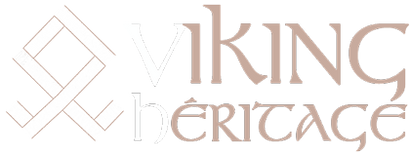🎁 It’s Black Friday Week: Get 10% off with the code BLACK10
🎁 It’s Black Friday Week: Get 10% off with the code BLACK10
Ragnarök
November 05, 2023 4 min read

Ragnarök in Norse Mythology: The Viking Apocalypse
The myth of Ragnarök is one of the most powerful and poignant in Norse mythology. It represents the end of the world, a cataclysm leading to the death of gods, the destruction of the universe, and its eventual rebirth. This epic narrative, rich in symbols and metaphors, continues to fascinate and inspire generations for its universal and timeless nature.
What does Ragnarök mean?
The word Ragnarök derives from Old Norse, where "ragna" means "of the gods" and "rök" stands for "fate or judgment". Literally, it could be interpreted as "the fate of the gods". In the poems of the Poetic Edda and the Prose Edda, Ragnarök is described as a series of apocalyptic events, including epic battles that will lead to the death of major divine figures like Odin, Thor, Freyr, and Loki. However, Ragnarök is not just the end; it is also the beginning of a new and purified world.
The Ominous Signs
Norse mythology describes several harbingers foretelling the start of Ragnarök. These omens include Fimbulwinter, three successive winters with no summer in between, during which chaos will reign and social bonds will crumble. Wars will break out, and brothers will kill each other for fleeting gains. Stars will disappear from the sky, leaving the universe in darkness.
The Onset of Chaos
Ragnarök will begin when the wolf Fenrir, released from its chains, begins to ravage the world. The serpent Jörmungand will emerge from the ocean to poison the sky and earth. The ships of the dead will sail alongside giants led by Loki to battle the gods. The horn Gjallarhorn will sound, calling gods and mortals to battle.
The Battle of Vigrid

On the plains of Vigrid, the Aesir gods, led by Odin, will face the forces of chaos. Legendary duels will unfold: Odin will be devoured by Fenrir, Thor will die after defeating Jörmungand but will succumb to its venom. Other battles will follow, each sealing the fate of the deities and heroes involved.
The Destruction of the World
The world will undergo natural disasters: the sun and moon will be swallowed by the celestial wolves Sköll and Hati, and the stars will go out. The earth will shake, mountains will collapse, and all bonds and order will be broken. Fire will consume everything, even Yggdrasil, the World Tree, will feel the flames.
The Rebirth
After the destruction, a new and pure world will emerge from the waters. The earth will be repopulated by two human survivors, Líf and Lífþrasir, who will hide in the Hoddmimir's forest. Some gods will also survive, including Baldr and Hodr, who will return to the new world to rebuild. A new sun, the daughter of the old one, will illuminate the sky.

Is Ragnarök over?
The question of whether Ragnarök is an event of the past, present, or future remains open to interpretation. Mythological texts present it as a prophecy, suggesting an inevitable event but not fixed in time. In the modern view, Ragnarök can be seen as a metaphor for the natural cycles of destruction and creation, rather than a literal historical or future event. For the ancient Norse, it perhaps represented an acceptance of finality and a reminder that even the most powerful are not immortal.
Where does Ragnarök take place?

Ragnarök is foretold to unfold across the Nine Worlds of Norse cosmology. These worlds include:
- Asgard: The realm of the Aesir, the principal tribe of gods associated with order and civilization, led by Odin.
- Midgard: The world of humans, that is, Earth, which is protected by Asgard and connected to it by the rainbow bridge Bifrost.
- Jotunheim: The world of the giants (Jotnar), often in conflict with the gods of Asgard.
- Vanaheim: The world of the Vanir, another tribe of gods associated with fertility, wisdom, and the ability to see the future.
- Alfheim: The world of the light elves, beings associated with beauty and magic.
- Svartalfheim: Also called Nidavellir, the world of dwarves and dark elves, famed for their skill in craftsmanship and metallurgy.
- Niflheim: A world of ice, mist, and cold, often associated with the dead.
- Muspelheim: A world of fire, flames, and heat, inhabited by fire demons and ruled by the fire giant Surtr.
- Helheim: The world of the dead, ruled by the goddess Hel, where those who do not die in battle reside.
During Ragnarök, it is said that all the worlds will be affected by the cataclysmic events, with battles taking place on the plains of Vigrid and the final destruction by fire and water, leading to the submergence of the Earth.
The impact of Ragnarök
Beyond mythology, Ragnarök has a profound impact on the understanding of Norse culture and identity. It embodies the themes of ephemerality, resilience, and renewal. These concepts are reflected in art, literature, and even contemporary philosophy. Ragnarök, as a symbol, continues to inspire modern works ranging from fantasy novels to movies and video games, proving its timelessness and ongoing relevance.
Ragnarök, with its themes of end and beginning, remains one of the most captivating myths of Norse mythology. It offers a window into the beliefs of the Vikings and their worldview. While we may never know if the ancient Norse believed in the literal reality of Ragnarök, its message is clear: after destruction comes rebirth. In this, Ragnarök is more than just a story; it is a teaching on resilience and hope in the face of the inevitable.
Leave a comment
Comments will be approved before showing up.




